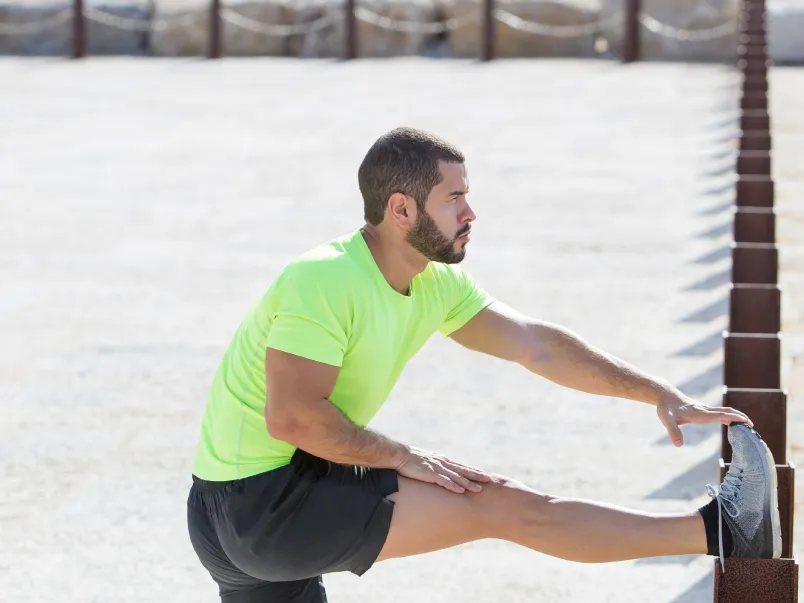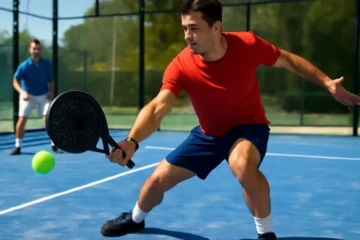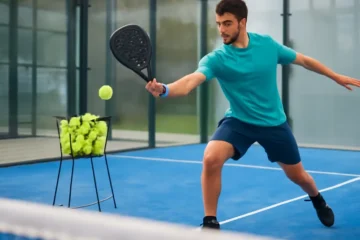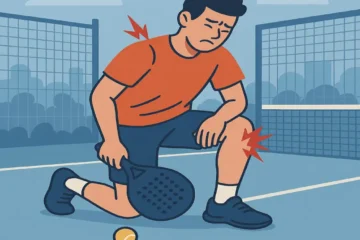Why Stretching is Your Secret Weapon in Padel
Padel is a fast-paced sport that demands explosive power, agility, and quick direction changes. Whether you’re lunging for a low ball or smashing it overhead, each movement puts a unique strain on your body. But as fun and thrilling as these actions are, they also increase the risk of injury. From tennis and golfer’s elbow to shoulder rotator cuff issues, knee strains, and groin pulls, padel players frequently deal with these common injuries caused by the explosive and multi-directional movements involved in the game.
The good news? Stretching can be your best ally in preventing these injuries. Incorporating a proper stretching routine into your training regimen can help increase flexibility, improve range of motion, boost blood flow, and reduce muscle soreness. In this guide, we’ll provide you with targeted stretching routines to perform before and after your padel matches to help you stay injury-free and perform at your best on the court.
Part 1: Understanding the Demands of Padel
To understand why stretching is crucial, it’s important to first examine the key muscle groups used in padel. This section explains the areas of the body that take the most strain during the sport.
Key Muscle Groups Used in Padel
Padel requires the use of several muscle groups, each essential to the game’s dynamic nature:
Shoulders & Rotator Cuff
Your shoulders and rotator cuff are heavily involved in smashes (such as bandejas and viboras) and volleys. These repetitive, high-intensity movements place a lot of strain on the shoulder joint and surrounding muscles.
Elbows & Forearms
The repetitive grip and wrist actions that padel players perform while hitting shots can put a lot of stress on the elbows and forearms. These areas are particularly vulnerable to conditions such as tennis elbow or golfer’s elbow.
Core (Abs & Lower Back)
Your core provides the stability required to generate power during rotational movements, such as twisting to hit a shot. It also helps with balance and posture during lateral movements on the court.
Hips & Glutes
Padel players perform numerous lunges, changes of direction, and low shots. The hip flexors and glutes are crucial for controlling these movements, and tightness in these areas can lead to discomfort and injury.
Legs (Quads, Hamstrings, Calves)
Explosive movements and jumps are a regular part of padel. Your quads, hamstrings, and calves play an integral role in providing the strength and mobility needed for these actions.
Ankles
The quick pivots and rapid direction changes required on the court place significant demands on the ankle joints. Ankle stability and flexibility are essential for avoiding sprains and other injuries.
Part 2: The Pre-Game: Dynamic Warm-Up (5-10 Minutes)
Before stepping onto the court, it’s essential to properly warm up your muscles and prepare your body for the dynamic movements involved in padel. A dynamic warm-up not only increases blood flow and heart rate but also activates the muscles you’ll use during the game. This type of warm-up isn’t about deep stretching but rather preparing your body for action.
Goal: Increase Heart Rate, Blood Flow, and Muscle Activation
Here is a dynamic warm-up routine you can follow before your padel game. Perform each exercise for 30-60 seconds to get your body primed for action:
- Light Cardio
Start with jogging or high knees on the spot for about two minutes. This gets your heart rate up and warms up your body. - Arm Circles & Swings
Perform forward and backward arm circles to loosen up your shoulders. This helps to activate the muscles that will be used during smashes and volleys. - Torso Twists
Gently rotate your torso to warm up your core. This movement will prepare your body for the rotational actions you’ll perform during the game. - Leg Swings
Swing each leg forward and backward and side-to-side to loosen up your hips and hamstrings. This also activates the muscles used for lunges and directional changes. - Walking Lunges
Perform walking lunges with a twist to engage both your lower body and core. This exercise helps with hip mobility and stability, which is essential for padel. - High Skips
Do high skips to activate your calves and ankles. This movement mimics the explosive action of jumping and pivots in the game. - Lateral Shuffles
Mimic the side-to-side movements you will make on the court by performing lateral shuffles. This activates your legs and hips and prepares you for quick lateral movements.
Part 3: The Post-Game Cool-Down: Static Stretching (10-15 Minutes)
After the game, it’s time to cool down your muscles with static stretching. Static stretching helps to improve flexibility, reduce muscle soreness, and aid in muscle recovery.
Goal: Relax Muscles, Improve Flexibility, and Reduce Stiffness
Here is a static stretching routine you can perform after your match. Hold each stretch for 20-30 seconds and repeat 2-3 times per side to ensure you get the full benefit.
Upper Body Stretches
- Neck and Trapezius Stretch
Gently pull your head to the side to stretch your neck and trapezius muscles. This will help release tension from the upper body. - Shoulder Stretch (Across Body)
Bring one arm across your chest and pull it closer to your body to stretch the shoulders. This is especially important for padel players who use their shoulders intensively. - Triceps Stretch
Reach one arm down the center of your back and gently pull your elbow to stretch the triceps. This helps to counteract the muscle tightness from overhead shots. - Forearm Extensor/Flexor Stretch
Gently pull back on your fingers and palm to stretch the forearm extensors and flexors. This stretch helps relieve the tension caused by gripping the racket.
Core & Lower Body Stretches
- Chest Opener (Doorway Stretch)
Stand in a doorway, place your arms on the frame, and gently lean forward to stretch your chest and pectorals. This helps release tightness from the chest muscles used in padel. - Lunge with Spinal Twist
Perform a lunge and twist your torso to the side to stretch your hips, quads, and core. This stretch improves flexibility in multiple areas that are used during padel. - Seated Hamstring Stretch
Sit down, extend one leg, and reach for your toes to stretch your hamstrings. This will help with flexibility and recovery after intense leg movements. - Pigeon Pose (or Figure-Four Stretch)
Perform a pigeon pose to stretch your glutes and hip rotators. This stretch is especially useful after the lunging and directional changes in padel. - Quadriceps Stretch
Stand and pull one heel towards your glutes to stretch the quadriceps. This stretch is essential for recovery after movements like squatting and jumping. - Calf Stretch
Place your hands against a wall, step one foot back, and bend the front knee to stretch your calves. This stretch is critical for releasing tension in the calves after quick lateral movements. - Groin Stretch (Butterfly Stretch)
Sit with the soles of your feet together, and gently push your knees down to stretch your groin. This stretch is vital for padel players who make wide, lateral movements.
Part 4: Bonus: Targeted Routines for Common Padel Issues
Padel players often deal with specific injuries related to the sport. Here are some targeted stretches for common padel issues:
- For Elbow Tenderness (Prevention of Tennis Elbow):
Focus on eccentric wrist flexor and extensor stretches. These stretches help strengthen the forearms and alleviate tension on the elbow joint. - For Tight Shoulders:
Deepen your rotator cuff and chest stretches to alleviate tightness in the shoulders. Regular shoulder stretches can prevent injury and improve your range of motion. - For Aching Knees:
Emphasize quad, hamstring, and IT band flexibility to support the knee joint. These stretches help reduce pressure on the knee and improve mobility.
Part 5: Key Principles & Mistakes to Avoid
To make your stretching routine as effective as possible, it’s important to follow these key principles:
- Listen to Your Body:
Stretch to the point of mild tension, not sharp pain. Pushing too hard can lead to injury, so always listen to your body and stay within your comfort zone. - Don’t Bounce:
Avoid ballistic stretching, which involves bouncing in and out of a stretch. Instead, hold each stretch steadily to avoid muscle strain. - Breathe:
Deep, consistent breathing helps relax your muscles and improve the effectiveness of your stretches. - Be Consistent:
It’s better to stretch for 10 minutes after every game than to do a long session once a week. Consistency is key to improving flexibility and preventing injury. - Hydrate:
Staying hydrated is essential for muscle recovery. Water helps your muscles stay flexible and reduces the risk of cramps.
Conclusion: Stay on the Court, Play Longer
Incorporating a proper stretching routine into your padel training will help you stay injury-free and improve your performance on the court. By focusing on both dynamic warm-ups before your game and static stretches afterward, you can prevent injuries, improve your flexibility, and recover faster.
Investing just 10-15 minutes in your body after every match will pay off in big dividends, allowing you to enjoy a longer, healthier, and more enjoyable padel career.
Call to Action: Lace up your shoes, grab your stretch mat, and make this routine as essential as your padel racket. Your body will thank you for it!
Frequently Asked Questions (FAQs) about Stretching for Padel
1. Why is stretching important for padel players?
Stretching is crucial for padel players because it helps prevent injuries, improve flexibility, and boost performance. By regularly stretching before and after your matches, you can reduce muscle soreness, increase your range of motion, and keep your body agile for the fast-paced movements of the game.
2. What type of stretching should I do before playing padel?
Before playing padel, you should focus on dynamic stretches, which help warm up your muscles and increase blood flow. Dynamic stretching includes exercises like arm circles, leg swings, torso twists, and walking lunges. These movements prepare your body for the explosive actions you’ll perform during the game, such as quick direction changes and powerful smashes.
3. What stretches should I do after playing padel?
After playing padel, you should focus on static stretching to help relax your muscles and improve flexibility. Static stretches include holding stretches like the hamstring stretch, pigeon pose, shoulder stretch, and calf stretch. These help cool down your muscles, reduce stiffness, and aid in recovery.
4. How long should I hold each stretch during my cool-down?
Each stretch should be held for 20-30 seconds and repeated 2-3 times per side. This gives your muscles enough time to relax and lengthen, improving flexibility and reducing the chances of post-game stiffness.
5. Can stretching help prevent injuries in padel?
Yes! Stretching can significantly reduce the risk of injuries by improving muscle flexibility, joint mobility, and muscle strength. Regular stretching helps prepare your muscles for the physical demands of padel and aids in recovery after each game, making it less likely that you will experience injuries like tennis elbow, shoulder issues, or muscle strains.
6. Should I stretch if I’m already injured?
If you’re already injured, it’s important to consult a healthcare professional before stretching. Some injuries may require specific rehabilitation exercises, and stretching could potentially worsen certain conditions if not done properly. For minor muscle tightness, gentle stretching can help, but always listen to your body and avoid overstretching.
7. How often should I stretch for padel?
For optimal performance and injury prevention, it’s recommended to stretch both before and after every padel match. A consistent routine of 5-10 minutes of dynamic stretches before playing and 10-15 minutes of static stretches afterward will help keep your body in peak condition.
8. Can stretching improve my padel performance?
Yes! Regular stretching can improve your flexibility, mobility, and muscle coordination, which directly impacts your performance on the court. By stretching regularly, you can move more fluidly, react quicker, and generate more power in your shots, giving you a competitive edge.
9. Is it better to stretch before or after a padel match?
Both pre-game and post-game stretching are important. Pre-game dynamic stretching helps to warm up your muscles and prepare your body for action, while post-game static stretching helps to cool down the muscles and improve flexibility. Incorporating both into your routine is the best way to enhance performance and prevent injury.
10. What if I don’t have time to stretch before or after playing?
Even if you’re short on time, try to incorporate a few quick stretches before and after your game. Prioritize dynamic stretches like leg swings and torso twists before playing, and static stretches like hamstring and calf stretches afterward. Even a shorter routine is better than none at all, and consistency is key for long-term benefits.
11. Can stretching prevent tennis elbow in padel players?
Yes, stretching can help prevent tennis elbow by improving flexibility and reducing muscle tension in the forearms, elbows, and wrists. Focus on wrist flexor and extensor stretches, as well as forearm stretches, to keep the muscles and tendons around the elbow joint flexible and strong.
12. Is it okay to stretch if I’m feeling sore after playing?
If you’re feeling sore after playing, gentle stretching can help alleviate tightness and improve blood circulation to the muscles. However, it’s important not to overstretch or force your body into uncomfortable positions. If the soreness is severe or persists, rest and consult a professional for guidance.




